
A few weeks ago, I got a studio visit from a close friend of mine who also plays guitar. He brought in with him a ‘70s Fender Stratocaster which plays and sounds fantastic, and that got us talking about the lifespan of guitars. We were wondering – How long do guitars last? And can it last more than a lifetime?
A guitar can last five, ten, fifty, or even a hundred years, depending on how it was cared for. High-quality guitars tend to be more durable and last longer than cheap ones, and solid-body guitars will last longer than hollow-body guitars due to their robust design.
In this article, we will investigate what causes guitar wear and tear, how it affects the guitar’s lifespan, and what we can do in order to protect our guitar and prolong its life.
The lifespan of an electric guitar (solid-body)
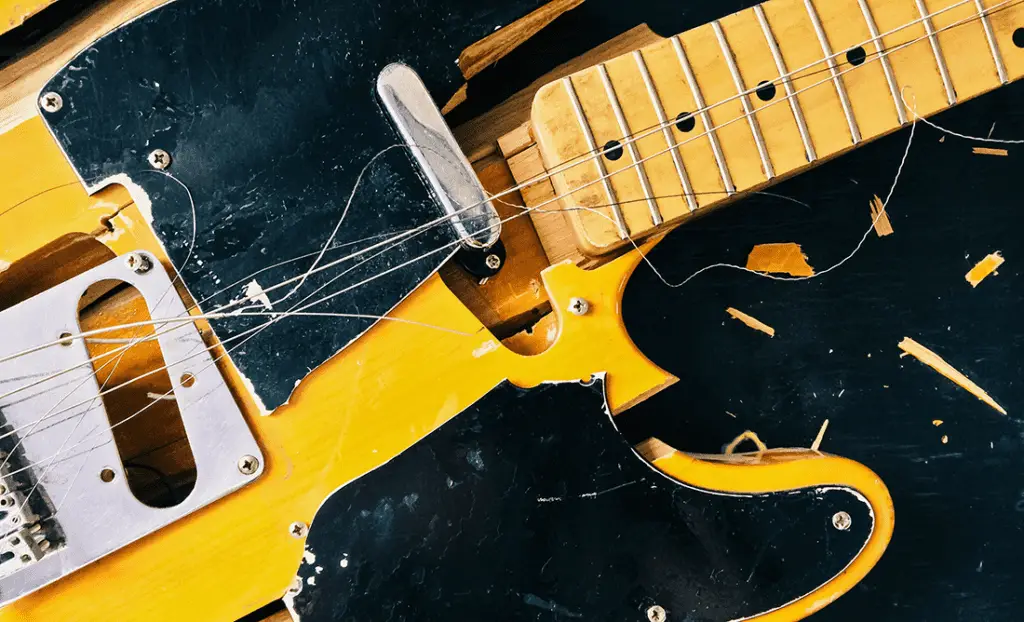
Notable guitar history moments like Hendrix setting his Stratocaster on fire or Kurt Cobain smashing his Fender Mustang into the amplifiers have become a symbol for rockstar-like behavior. But even though we grew up on these images, we mere mortals who cannot afford to replace a guitar every week simply need to protect our guitars and keep them from degrading as much as we can.
A guitar’s lifespan is determined not only by its materials and quality of craftsmanship but also by its owner’s will and capability to preserve it. One might say it is even what counts most when talking about prolonging the life of a musical instrument.
Let’s take a closer look at the things that affect the lifespan of an electric guitar:
Solid-body electric guitars
In comparison to acoustic, hollow-body electric, or classical guitars, solid-body electric guitars are more durable. The solid body, which is a lot bulkier, can withstand harsher changes in humidity and temperature without twisting or warping. The paint job on solid bodies is also thicker, which adds another sturdy layer of protection.
Electronics
In comparison to classical or acoustic guitars, electric guitars contain more electronic components which are susceptible to corrosion damage. The bridge, strings, pickup magnets, switches, strap locks, inner electronics, or even the frets and tuners will eventually rust. The best corrosion protection for electronic components is coating and enclosing. A layer of coating will protect the hardware from any outside humidity, and proper encasement will add a second layer of protection.
Guitar Pickups
Guitar pickups are usually soaked in wax at the end of the manufacturing process, and that extra layer of wax can crumble away after years of use. This layer of wax protects the pickup from humidity and keeps the components in place. Waxing also has a tonal influence that can negate signal feedbacks. A guitar technician can re-wax an old pickup and restore it to its former glory.
To protect the outer components of your guitar like the bridge, tuners, and tone knobs, clean them every now and then. Use Dunlop 65 guitar cleaner for general guitar cleaning or Dr.Ducks Axe Wax to give your guitar an extra layer of protection (Axe Wax is good for wood outer electronics like the pickups, bridge, and even strings), for the inner electronic components use Servisol Super 10.
Conclusion
The lifespan of an electric guitar is determined by how it is being handled. It may last five, ten, or twenty years if being misused and a century or more if it is adequately treated. The first electric guitar, the Frying Pan, which came out in 1932, is almost a hundred years old and is completely playable even today.
Most durable solid-body guitars:
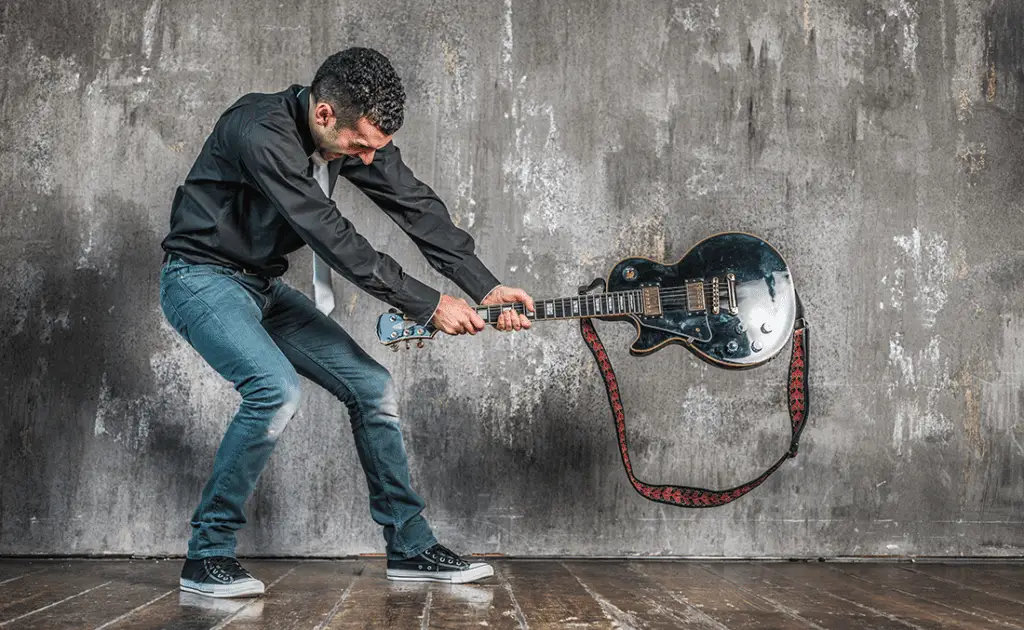
The most durable solid-body electric guitars are the Fender Stratocaster and Telecaster. According to professional guitar players and technicians, these workhorse models are tonally more stable, harder to break, and easier to treat than other guitars while maintaining the high-quality signal and feel expected from a professional instrument.
The lifespan of an acoustic guitar
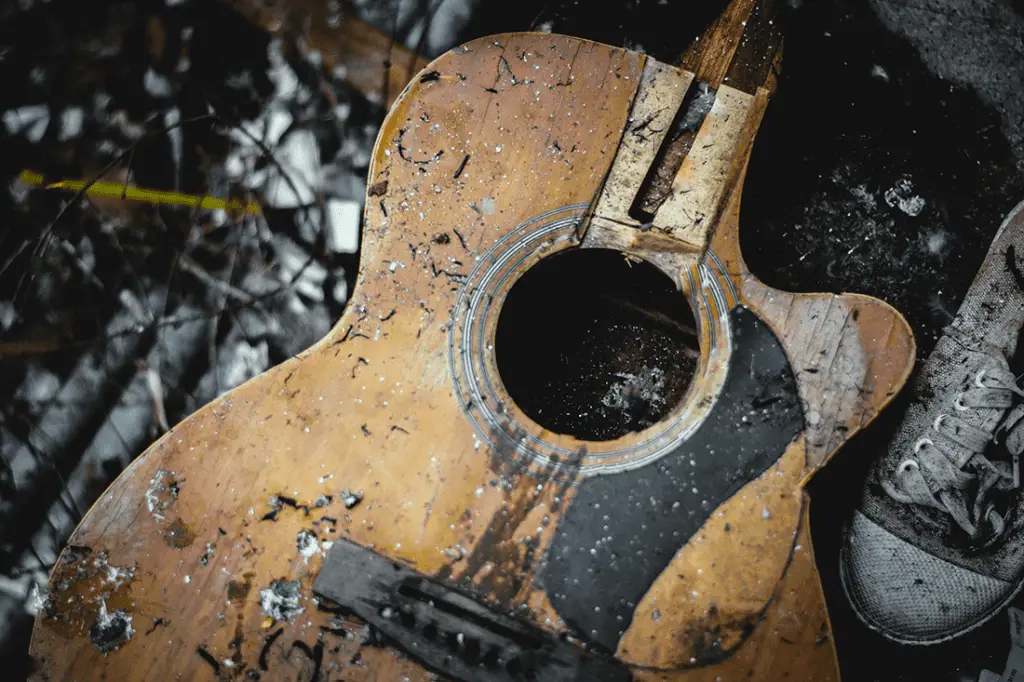
The structural integrity of an acoustic guitar, much like its soundscape, is gentler than the one of a solid-body guitar. It is built almost entirely of wood and has a much lighter finish. Naturally, it will last less than an electric guitar but can still last a very long time.
Structure
Acoustic guitars are built to produce sound organically with the help of a soundhole (also called a sound chamber). Unfortunately, this design makes them more fragile than solid-body guitars. The inside of an acoustic guitar is not painted or sealed in any way as it would damage the guitar’s sound quality. This makes these guitars more susceptible to humidity and temperature damage.
Strings
The strings on acoustic guitars are usually thicker than on electric guitars, generating more tension and pressure on the guitar’s neck, bridge, and body. In addition, acoustic guitars are built out of thin wood boards and braces, putting them at a higher risk of breakage.
The sound of an acoustic guitar may change significantly over time (in comparison to electric guitars) due to changes in the wood’s humidity levels. After years of drying, the wood becomes more stable and less susceptible to environmental changes. It also makes the guitar produce a higher volume.
Conclusion
The lifespan of an acoustic guitar is determined by how you use it. If mistreated, it will last five to around ten years. If handled professionally and stored under the right conditions, it will last decades, moving from father to son.
The lifespan of a classical guitar
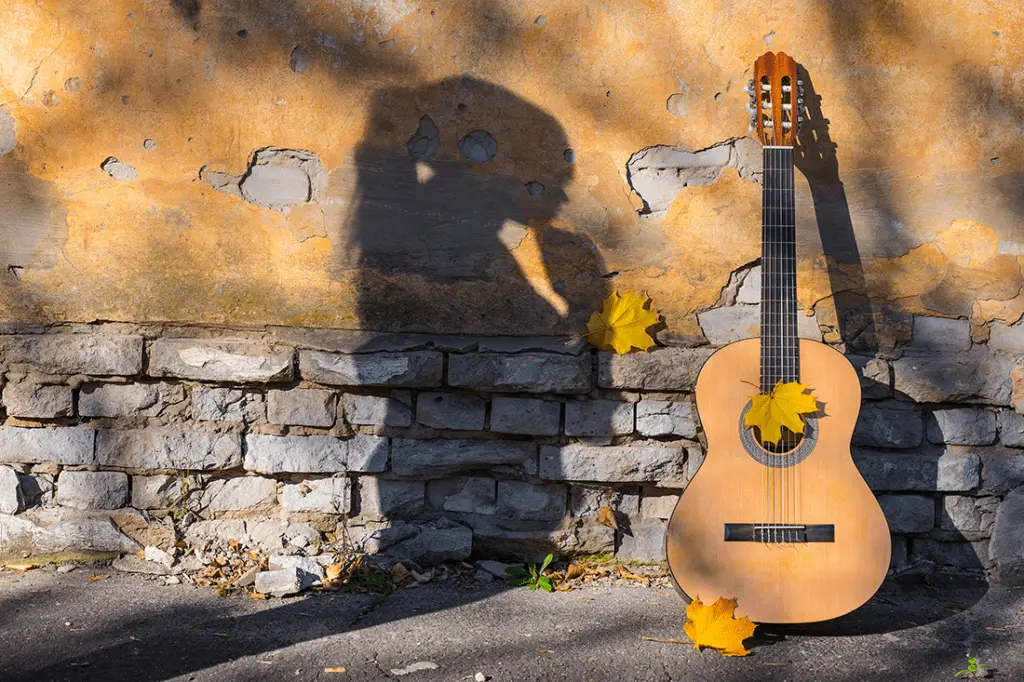
Classical guitars are structurally similar to acoustic guitars; they are also made almost entirely out of wood, produce sound organically with the help of a soundhole, and don’t have any type of inner coating.
Unlike acoustic guitars, classical guitars come with nylon strings that are more flexible than metal strings and generate less stress on the guitar’s neck and body. This is why classical guitars don’t require a truss rod and are less likely to snap a bridge.
Treating classical guitars is similar to treating acoustic guitars or any other wooden instrument. Protect it from excessively humid environments and high temperatures, and make sure to keep it clean, waxed (using Axe Wax), and properly stored. Classical guitars are also extremely lightweight and can dent or break relatively easily around the body area.
Just like any other guitar, the lifespan of a classical guitar depends on its quality, how much it has been played, and how it has been cared for. They will last 5-15 years if poorly cared for or decades if they are properly handled and professionally treated.
How to take care of your guitar and prolong its life
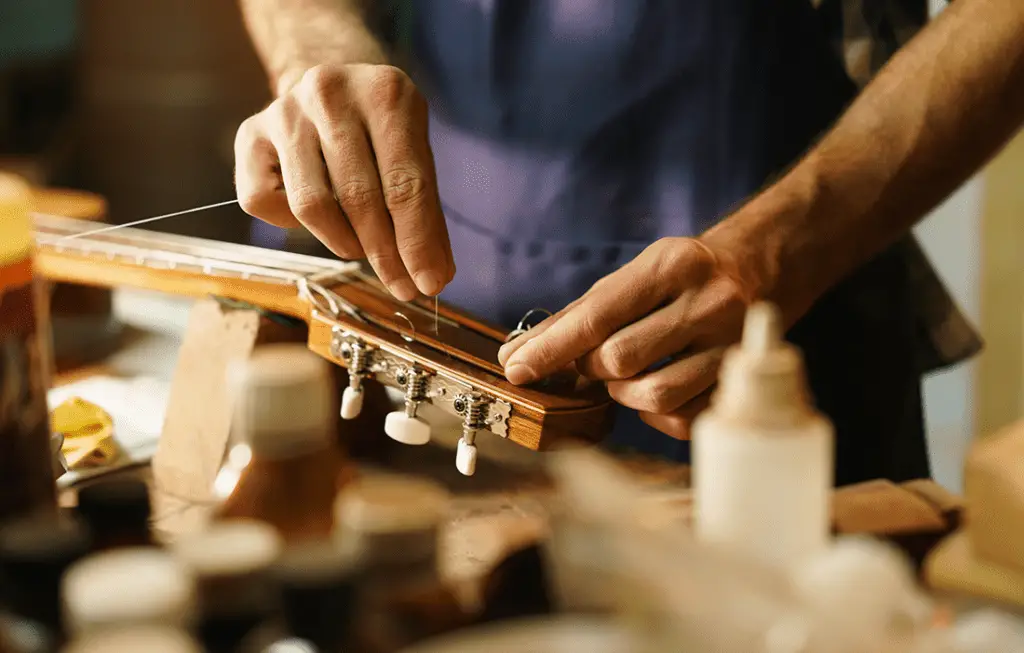
Humidity protection
Both wood and metal, the primary materials used in building electric, acoustic, and classical guitars, are heavily affected by the humidity in the air. Wood will expand and contract according to humidity changes, and metal components will rust when humidity levels climb. Extreme humidity levels can even promote mold, while low humidity levels can make wood crack.
Make sure to keep your guitars in a place with balanced humidity levels. The optimal humidity level for guitars is about 45%-55% relative humidity (RH). You can monitor humidity levels in your studio using a hygrometer (humidity meter) or even the levels inside your guitar case using a wireless sensor (that can send notifications to your phone when humidity levels get too dangerous). There are also regular humidity packs for guitars that will keep the humidity levels in your case at the optimal range.
Beware of dangerous temperatures
Keep your guitars away from heaters, air conditions, or even direct sun (especially if you live in a place with a warm climate) to protect them from overheating. Extreme temperatures can warp the wood of your guitar resulting in twisted necks, changes in saddle height, and weakening of glue joints.
Never forget or store your guitar in the car. It can quickly turn into an oven if left in the sun for just a while during summer. Outdoor stages can also be dangerous territories for guitars, especially in venues that take place when the sun is up. Make sure to store your guitars in a case between the soundcheck and the show, and ask the manager for some on-stage shading.
Aside from overheating, UV radiation can also damage the guitar’s finish. Overexposure to sunlight may result in darkening of the lacquer, changes in color, and even the yellowing of white plastic parts like the pickguard or bridge pins.
Proper storage
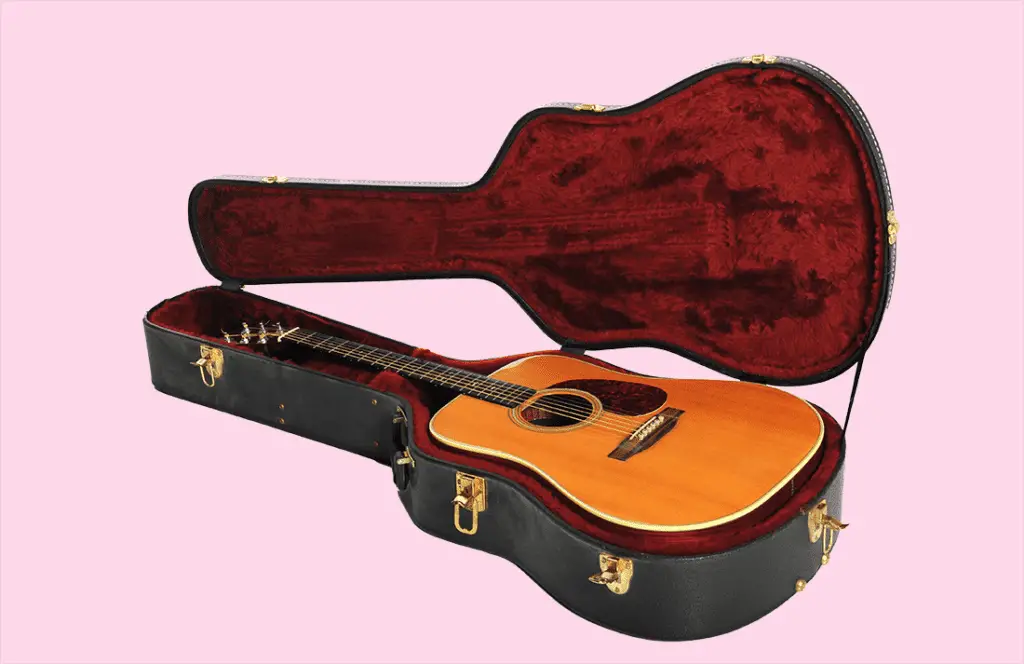
As a guitar teacher, I always tell my students to keep their guitars outside of the case, on a stand, so they can quickly grab them every time they want to practice. I would tell them to do the exact opposite if the goal is to preserve the guitar as much as possible.
By storing a guitar in a case or a closet, we minimize environmental changes inflicted on it. When humidity and temperature levels are stable, the wood’s natural movement is kept to a minimum (making the process aging much more gradual), chances of corrosion in metallic parts drop, and the guitar’s finish lasts longer.
If you live in a place with harsh climates, make sure to store your guitar closer to the building’s center as it stays more environmentally stable compared to near outer walls as the seasons change.
For maximum protection, store your guitar in a hard case. It is much more durable than a soft case and provides better insulation against humidity and temperature changes.
The importance of replacing guitar strings
Metal strings of acoustic and electric guitars rust quickly and will usually last between a week and four weeks, depending on how much you play and under what conditions. Replacing your strings might be more important than you realize because when rust builds up on a guitar string, it turns grainy, promoting much more fret-wear with each press and bend.
Keep your guitar clean
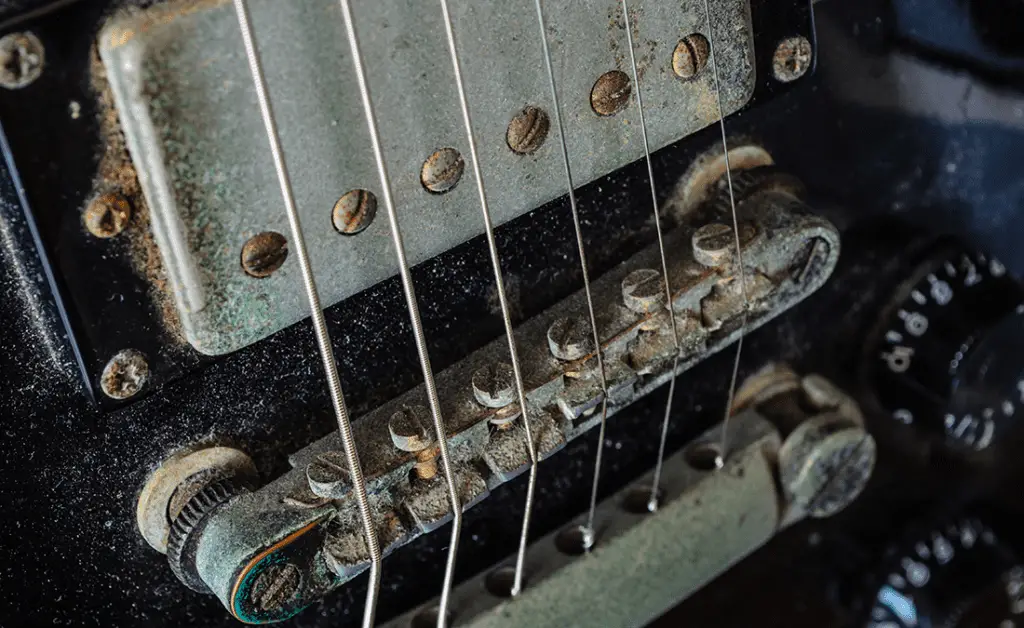
Dirt, dust, rust, skin oil, sweat, spilled beverages, smoke, or any other type of filth can prematurely age your guitar. This unnecessary damage can be avoided with just a little bit of cleaning, plus you’ll end up with a guitar that looks good and feels nice and smooth.
Make sure to wipe the guitar’s strings before and after playing using a lint-free cloth, and occasionally wipe the guitar’s hardware. Clean the guitar’s neck, body, and fretboard with the Dunlop 65 cleaner and some cotton wool (tissue paper and towels can scratch guitar finish). Do not use water, furniture cleaning agents, or glass cleaners as they may damage the guitar’s finish.











